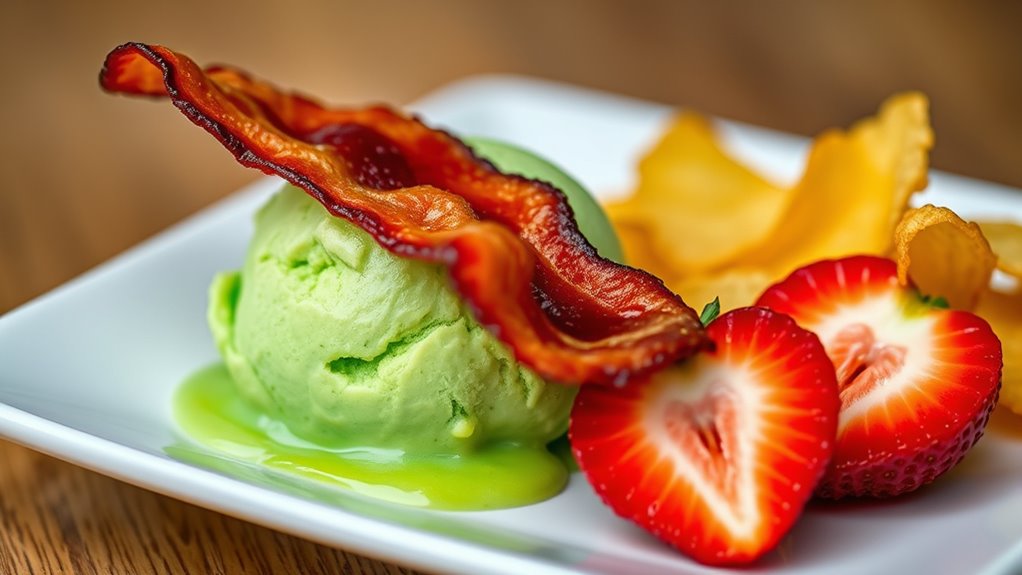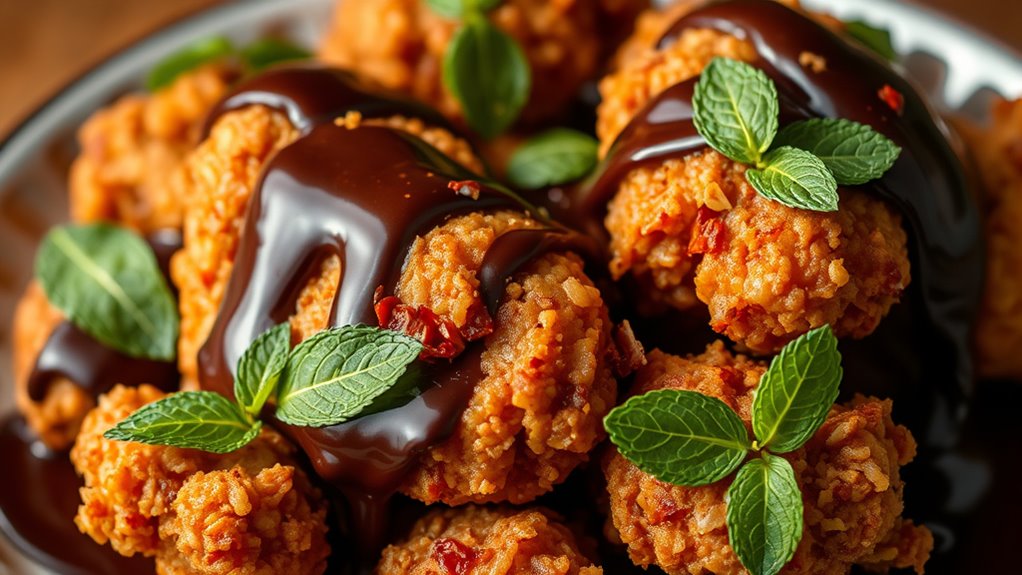Unlikely food pairings work because they tap into scientific principles that make contrasting flavors, textures, and aromas work together into memorable dishes. When you combine ingredients like sweet fruit with savory cheese or spicy salsa with grilled fish, your senses experience aroma, texture, and temperature interacting for harmony. These mashups challenge traditional ideas and highlight how understanding sensory interactions and chemical reactions can create delightful surprises. Explore further to discover how these bold combinations can elevate your culinary experiments.
Key Takeaways
- Scientific analysis reveals aroma compounds and chemical interactions that explain why unlikely ingredients can complement each other.
- Sensory principles like contrasting textures and temperatures enhance flavor perception in mashups.
- Cultural influences shape unique ingredient pairings, blending diverse culinary traditions creatively.
- Understanding sensory processing enables chefs to experiment confidently with innovative flavor combinations.
- Recognizing how ingredients interact at chemical and sensory levels fosters the creation of memorable, surprising dishes.

Flavor mashups are transforming the way we experience food by combining unexpected ingredients to create bold, exciting tastes. When you explore these unlikely pairings, you’re tapping into a world of culinary innovation that challenges traditional notions of flavor harmony. One key aspect behind these daring combinations is the influence of cultural influences, which shape how different ingredients are perceived and enjoyed. For example, what’s considered a strange pairing in one cuisine might be a beloved classic in another. By blending elements from diverse culinary traditions, you open yourself up to new taste experiences that reflect a rich tapestry of cultural history and preferences. These influences often bring together ingredients that, on the surface, seem incompatible, but when combined thoughtfully, they evoke a sense of familiarity mixed with novelty. Additionally, understanding inspirational quotes about fatherhood can remind us of the importance of nurturing and support, much like a good flavor pairing enhances a dish.
At the heart of successful flavor mashups are sensory interactions—how your senses work together to create a harmonious or intriguingly discordant experience. Your palate doesn’t evaluate flavors in isolation; it responds to the interplay of aroma, texture, temperature, and taste. For instance, the sweetness of fruit can be heightened when paired with the umami of cheese, or the crunchiness of vegetables can contrast beautifully with the creaminess of a sauce. These sensory interactions can amplify or mellow certain flavors, making unlikely combinations more palatable and even addictive. When you taste a mashup like spicy mango salsa on grilled fish, your senses are engaged in a complex dance—hot, sweet, tangy, and savory all at once—each element enhancing the others. This delicate balance is what turns a simple pairing into a memorable culinary experience.
Understanding the science behind these interactions can help you experiment confidently in the kitchen. Recognizing how different ingredients influence each other through aroma compounds, chemical reactions, or textural contrasts empowers you to create your own flavor mashups. For example, adding a hint of citrus can brighten a deep, hearty dish, or combining salty and sweet ingredients can elevate a dessert to new heights. These principles are rooted in the way our sensory system perceives and processes complex stimuli, making it possible for unlikely ingredients to complement each other rather than clash.
In essence, flavor mashups are a celebration of diversity—culinary, cultural, and sensory. They invite you to break free from conventions, encouraging you to explore how different influences and interactions can transform ordinary ingredients into extraordinary dishes. By understanding the science behind these combinations, you can craft innovative flavors that surprise and delight, proving that sometimes, the most unlikely pairings are the most memorable.
Frequently Asked Questions
How Do Cultural Influences Shape Unexpected Flavor Combinations?
Your cultural identity greatly influences unexpected flavor combinations by blending traditional ingredients with new culinary ideas. As you explore different cuisines, you participate in culinary innovation, mixing flavors inspired by diverse cultural influences. These combinations often challenge norms, creating exciting and unique dishes. By embracing your cultural roots and experimenting with unfamiliar pairings, you help expand culinary boundaries, making food a dynamic reflection of cultural exchange and creativity.
Can Food Pairing Experiments Improve Overall Taste Satisfaction?
Yes, food pairing experiments can improve your overall taste satisfaction by enhancing flavor perception and encouraging culinary innovation. When you try unlikely combinations, you challenge your palate and discover new taste dimensions, making eating more exciting. These experiments push boundaries, helping you appreciate complex flavors and develop a deeper understanding of food. Embracing such adventures can lead to more enjoyable, memorable meals and inspire your creativity in the kitchen.
What Role Does Texture Play in Flavor Mashups?
Texture acts like a dance floor, guiding your taste buds through a symphony of sensations. It plays a vital role in flavor mashups by creating mouthfeel contrast and enhancing textural harmony. When different textures combine thoughtfully, they elevate the overall experience, making each bite more exciting. Without this balance, even bold flavor pairings can fall flat. So, paying attention to texture helps you enjoy the full depth of your culinary adventure.
Are There Health Benefits to Certain Unconventional Food Pairings?
Yes, some unconventional food pairings can offer health benefits. For example, combining fermented foods like kimchi or yogurt provides probiotic benefits that support your gut health. Additionally, pairing antioxidant-rich ingredients such as berries with dark chocolate boosts your intake of antioxidants, which help combat free radicals. Trying these unexpected combinations can make your meals more nutritious while satisfying your curiosity and taste buds.
How Do Sensory Perceptions Affect Our Acceptance of New Flavor Combinations?
Imagine your senses as a vibrant symphony, where olfactory cues and taste adaptation harmonize to shape your acceptance of new flavors. When you encounter unfamiliar combinations, your sensory perceptions can either spark curiosity or trigger rejection. By gradually introducing these pairings, your senses adapt, opening your mind and palate. This sensory interplay influences whether you embrace or shy away from bold, unlikely flavor mashups, turning the unknown into a delightful discovery.
Conclusion
So, next time you stumble upon an unexpected flavor combo, remember there’s more at play than just taste. The science behind these mashups reveals hidden connections waiting to be uncovered. Will your daring pairing unseal a new favorite or spark a surprising twist in your culinary journey? The possibilities are endless—and the secret ingredients might just be lurking where you least expect. Stay curious, because the next flavor mashup could change everything you thought you knew about food.









